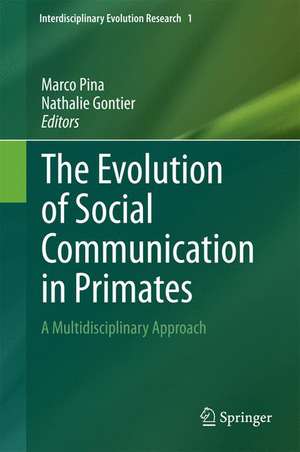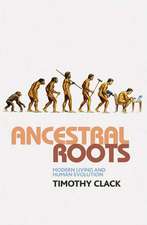The Evolution of Social Communication in Primates: A Multidisciplinary Approach: Interdisciplinary Evolution Research, cartea 1
Editat de Marco Pina, Nathalie Gontieren Limba Engleză Hardback – 13 iun 2014
| Toate formatele și edițiile | Preț | Express |
|---|---|---|
| Paperback (1) | 946.41 lei 43-57 zile | |
| Springer International Publishing – 23 aug 2016 | 946.41 lei 43-57 zile | |
| Hardback (1) | 948.92 lei 43-57 zile | |
| Springer International Publishing – 13 iun 2014 | 948.92 lei 43-57 zile |
Preț: 948.92 lei
Preț vechi: 1157.22 lei
-18% Nou
Puncte Express: 1423
Preț estimativ în valută:
181.63€ • 197.36$ • 152.67£
181.63€ • 197.36$ • 152.67£
Carte tipărită la comandă
Livrare economică 21 aprilie-05 mai
Preluare comenzi: 021 569.72.76
Specificații
ISBN-13: 9783319026688
ISBN-10: 3319026682
Pagini: 326
Ilustrații: X, 326 p. 18 illus., 11 illus. in color.
Dimensiuni: 155 x 235 x 25 mm
Greutate: 0.54 kg
Ediția:2014
Editura: Springer International Publishing
Colecția Springer
Seria Interdisciplinary Evolution Research
Locul publicării:Cham, Switzerland
ISBN-10: 3319026682
Pagini: 326
Ilustrații: X, 326 p. 18 illus., 11 illus. in color.
Dimensiuni: 155 x 235 x 25 mm
Greutate: 0.54 kg
Ediția:2014
Editura: Springer International Publishing
Colecția Springer
Seria Interdisciplinary Evolution Research
Locul publicării:Cham, Switzerland
Public țintă
ResearchCuprins
Introduction.- PART I: Philosophical and Historical Roots of Social Communication Studies.- Lord Monboddo’s Ourang Outang and the Origin and Progress of Language.- Ferality and Morality; The Politics of the “Forbidden Experiment” in the Twentieth Century.- PART II: The Elements of Social Communication in Primates and Humans.- Experimental Conversations: Sign Language Studies with Chimpanzees.- How Primate Mothers and Infants Communicate: Characterizing Interaction in Mother-Infant Studies.- On Prototypical Facial Expressions vs. Variation in Facial Behavior: What Have We Learned on the “Visibility” of Emotions from Measuring Facial Actions in Humans and Apes.- The Evolution of Joint Attention: A Review and Critique.- Describing Mental States: From Brain Science to a Science of Mind Reading.- PART III: Evolutionary Transitions from Social Communication Systems to Language.- Bodily Mimesis and the Transition to Speech.- From Grasping to Grooming to Gossip: Innovative Use of ChimpanzeeSignals in Novel Environments Supports both Vocal and Gestural Theories of Language Origins.- Reevaluating Chimpanzee Vocal Signals from the Ground Up.- PART IV: Evolutionary Origins of Human Language.- Communication and Human Uniqueness.- How did Humans Become Behaviorally Modern? Revisiting the ‘Art First’ Hypothesis.- Experiments and Simulations Can Inform Evolutionary Theories of the Cultural Evolution of Language.- The Emergence of Modern Communication in Primates: a Computational Approach.- What Can an Extended Synthesis do for Bio linguistics: On the Need and Benefits of the Eco-evo-devo Program.
Recenzii
“This volume provides a review of some of the many theoretical frameworks proposed to investigate the evolution of social communication in primates and in particular language in humans. … a rich, thought-provoking, and multidisciplinary book that would appeal to any scholar interested in the origins and evolution of language and communication.” (Roberta Salmi, The Quarterly Review of Biology, Vol. 90, September, 2015)
“This edited volume aims to provide a … series of reviews and critiques of most currently available methodological and theoretical frameworks that guide research on the mechanisms and evolution of primate social communication and human language. … Summing Up: Recommended. Graduate students and researchers/faculty.” (J. B. Leca, Choice, Vol. 52 (6), February, 2015)
“This edited volume aims to provide a … series of reviews and critiques of most currently available methodological and theoretical frameworks that guide research on the mechanisms and evolution of primate social communication and human language. … Summing Up: Recommended. Graduate students and researchers/faculty.” (J. B. Leca, Choice, Vol. 52 (6), February, 2015)
Notă biografică
MarcoPina has a background in medicine which he applies to topics in philosophy ofbiology and philosophy of medicine. He is currently preparing a doctoraldissertation on the development of the mind-brain dyad in the context of thenature/nurture debate, which is funded by the Portuguese Fund for Science andTechnology and executed at the Faculty of Science of the Portuguese Universityof Lisbon. Previously, as a scientific collaborator for the Centre forPhilosophy of Science of the University of Lisbon as well as its AppliedEvolutionary Epistemology Lab, he has edited several books on evolutionarytheory, language evolution, and the evolution of man.
NathalieGontier is a philosopher of science and an anthropologist. Her main researchinterests lie in evolutionary epistemology and non-Darwinian evolutionarytheories, how the latter differ from the Modern Synthesis and how they can beimplemented into the linguistic sciences and the overall sociocultural domain.As the founding director of the Lisbon Applied Evolutionary Epistemology Lab,she is affiliated to the Centre for Philosophy of Science at the Faculty ofScience of the University of Lisbon, and financed by the Portuguese Fund forScience and Technology. Previous appointments were held at the Dutch FreeUniversity of Brussels (Belgium), the Konrad Lorenz Institute (Austria), andthe American Museum of Natural History (USA). Her research has been sponsoredby the American John Templeton Foundation, the European Marie Curie Actions andthe Belgian Fund for Scientific Research Flanders. She is the founder andeditor-in-chief of the Springer book series Interdisciplinary EvolutionResearch.
NathalieGontier is a philosopher of science and an anthropologist. Her main researchinterests lie in evolutionary epistemology and non-Darwinian evolutionarytheories, how the latter differ from the Modern Synthesis and how they can beimplemented into the linguistic sciences and the overall sociocultural domain.As the founding director of the Lisbon Applied Evolutionary Epistemology Lab,she is affiliated to the Centre for Philosophy of Science at the Faculty ofScience of the University of Lisbon, and financed by the Portuguese Fund forScience and Technology. Previous appointments were held at the Dutch FreeUniversity of Brussels (Belgium), the Konrad Lorenz Institute (Austria), andthe American Museum of Natural History (USA). Her research has been sponsoredby the American John Templeton Foundation, the European Marie Curie Actions andthe Belgian Fund for Scientific Research Flanders. She is the founder andeditor-in-chief of the Springer book series Interdisciplinary EvolutionResearch.
Textul de pe ultima copertă
How did social communication evolve in primates? In this volume, primatologists, linguists, anthropologists, cognitive scientists and philosophers of science systematically analyze how their specific disciplines demarcate the research questions and methodologies involved in the study of the evolutionary origins of social communication in primates in general, and in humans in particular. In the first part of the book, historians and philosophers of science address how the epistemological frameworks associated with primate communication and language evolution studies have changed over time, and how these conceptual changes affect our current studies on the subject matter. In the second part, scholars provide cutting-edge insights into the various means through which primates communicate socially in both natural and experimental settings. They examine the behavioral building blocks by which primates communicate, and they analyze what the cognitive requirements are for displaying communicative acts. Chapters highlight cross-fostering and language experiments with primates, primate mother-infant communication, the display of emotions and expressions, manual gestures and vocal signals, joint attention, intentionality and theory of mind. The primary focus of the third part is on how these various types of communicative behavior possibly evolved, and how they can be understood as evolutionary precursors to human language. Leading scholars analyze how both manual and vocal gestures gave way to mimetic and imitational protolanguage, and how the latter possibly transitioned into human language. In the final part, we turn to the hominin lineage, and anthropologists, archeologists and linguists investigate what the necessary neurocognitive, anatomical and behavioral features are in order for human language to evolve, and how language differs from other forms of primate communication.
Caracteristici
Provides a unique multidisciplinary approach to understand the evolution of social communication Written by experts from various disciplines, such as primatology, linguistics, anthropology, cognitive science and philosophy Discusses historical and philosophical aspects Includes supplementary material: sn.pub/extras























